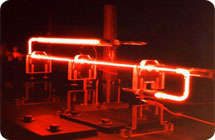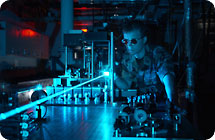Location:Home > News >
Knowledge about History of Fiber Optics from changguang(2)
The laser was introduced in 1958 as a efficient source of light. The concept was introduced by Charles Townes and Arthur Schawlow to show that masers could be made to operate in optical and infrared regions. Basically, light is reflected back and forth in an energized medium to generate amplified light as opposed to excited molecules of gas amplified to generate radio waves, as is the case with the maser. Laser stands for "light amplification by stimulated emission of radiation."


Helium-neon Gas Laser
A helium-neon gas laser (He-Ne) is tested in a laboratory setting. The laser tube is made from lead glass- the same glass used in neon signs. Image courtesy of J&K Lasers.
In 1960, the first continuously operating helium-neon gas laser is invented and tested. That same year an operable laser was invented which used a synthetic pink ruby crystal as the medium and produced a pulse of light.
In 1961, Elias Snitzer of American Optical published a theoretical description of single mode fibers whose core would be so small it could carry light with only one wave-guide mode. Snitzer was able to demonstrate a laser directed through a thin glass fiber which was sufficient for medical applications, but for communication applications the light loss became too great.
Charles Kao and George Hockham, of Standard Communications Laboratories in England, published a paper in 1964 demonstrating, theoretically, that light loss in existing glass fibers could be decreased dramatically by removing impurities.
In 1970, the goal of making single mode fibers with attenuation less then 20dB/km was reached by scientists at Corning Glass Works. This was achieved through doping silica glass with titanium. Also in 1970, Morton Panish and Izuo Hayashi of Bell Laboratories, along with a group from the Ioffe Physical Institute in Leningrad, demonstrated a semiconductor diode laser capable of emitting continuous waves at room temperature.
Laser Testing by the Military
Military scientists have utilized laser technology for variety of military applications.
In 1973, Bell Laboratories developed a modified chemical vapor deposition process that heats chemical vapors and oxygen to form ultra-transparent glass that can be mass-produced into low-loss optical fiber. This process still remains the standard for fiber-optic cable manufacturing.


The first non-experimental fiber-optic link was installed by the Dorset (UK) police in 1975. Two years later, the first live telephone traffic through fiber optics occurs in Long Beach, California.
In the late 1970s and early 1980s, telephone companies began to use fibers extensively to rebuild their communications infrastructure.
Sprint was founded on the first nationwide, 100 percent digital, fiber-optic network in the mid-1980s.
The erbium-doped fiber amplifier, which reduced the cost of long-distance fiber systems by eliminating the need for optical-electrical-optical repeaters, was invented in 1986 by David Payne of the University of Southampton and Emmanuel Desurvire at Bell Labratories. Based on Desurvire's optimized laser amplification technology, the first transatlantic telephone cable went into operation in 1988.
In 1991, Desurvire and Payne demonstrated optical amplifiers that were built into the fiber-optic cable itself. The all-optic system could carry 100 times more information than cable with electronic amplifiers. Also in 1991, photonic crystal fiber was developed. This fiber guides light by means of diffraction from a periodic structure rather then total internal reflection which allows power to be carried more efficiently then with conventional fibers therefore improving performance.
The first all-optic fiber cable, TPC-5, that uses optical amplifiers was laid across the Pacific Ocean in 1996. The following year the Fiber Optic Link Around the Globe (FLAG) became the longest single-cable network in the world and provided the infrastructure for the next generation of Internet applications.
Today, a variety of industries including the medical, military, telecommunication, industrial, data storage, networking, and broadcast industries are able to apply and use fiber optic technology in a variety of applications.
Get in Touch
+86-21-3996-3837
alex@changguangchina.com
+86-15216725374


